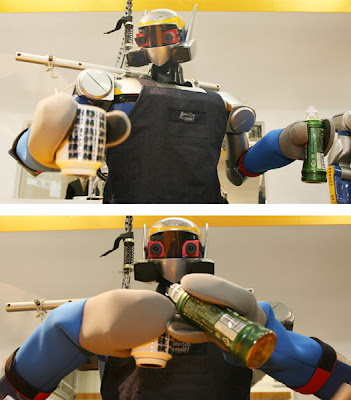 Just name a boring or dangerous job; somewhere, a robot is probably doing it. Robot do not know the meaning of exhaust, boring, dissapointed, angry and so on but just fill it with power (battery or something) and it will work for you. It also will not disobey, objects and gives comment to your controlling so far. But maybe in the future there are robots that have feelings and can argue with humans, who knows right?
Just name a boring or dangerous job; somewhere, a robot is probably doing it. Robot do not know the meaning of exhaust, boring, dissapointed, angry and so on but just fill it with power (battery or something) and it will work for you. It also will not disobey, objects and gives comment to your controlling so far. But maybe in the future there are robots that have feelings and can argue with humans, who knows right?| Robotic Arm arranging chocolates in boxes. Photo courtesy of Adept Technology, Inc. |
Another example of a factory job done by robots is arranging chocolates in boxed assortments. Guided by a computer vision system, a robotic arm can locate a piece of chocolate on a moving conveyer belt, gently pick it up and turn it to the proper orientation, then deposit it in a specific location within a box on another moving conveyer belt. Sure, it’s a task that almost anyone could do. . .but could you do it 20,000 times over the course of an eight-hour shift?
Robots are being put to a wider variety of manufacturing uses each day. In the computer industry, robots solder tiny wires to semiconductor chips. "Pick and place" robots insert integrated circuits onto printed circuit boards; these are used in all kinds of electronics, from radios to microwaves. Robots are also at work making and packaging drugs, textiles, and foods.
Certain dangerous jobs are best done by robots. Bomb disposal is one of these. Guided remotely using video cameras, robots like the Mini-Andros can be sent to investigate–and defuse–possible bombs.

 ANDROS F6A with PAN Disrupter mount.
ANDROS F6A with PAN Disrupter mount. ANDROS F6A with PAN Disrupter mount.
ANDROS F6A with PAN Disrupter mount. ANDROS Mark V-A1 with Chemical Sensor Mount and APD 2000 detector.
ANDROS Mark V-A1 with Chemical Sensor Mount and APD 2000 detector. ANDROS F6A with Window Breaker and Dual PAN Disrupter mount.
ANDROS F6A with Window Breaker and Dual PAN Disrupter mount. ANDROS F6A on toes with SL6 shotgun and mount.
ANDROS F6A on toes with SL6 shotgun and mount. This big blue box is a solar-powered, self-propelled machine designed to act as an observation post on the polar landscape.
This big blue box is a solar-powered, self-propelled machine designed to act as an observation post on the polar landscape. A robot built to mimic a real-life salamander heads for the waters of Lake Geneva.
A robot built to mimic a real-life salamander heads for the waters of Lake Geneva. You probably won't see a robo-barista at your local Starbucks anytime soon, but in Japan a new generation of robots is in training to serve tea.
You probably won't see a robo-barista at your local Starbucks anytime soon, but in Japan a new generation of robots is in training to serve tea. This peppy little fellow is i-Sobot, unveiled in Tokyo by Japanese toy giant Takara Tomy. At just over 6 inches tall, it's the world's smallest humanoid robot, the company says. It has 17 actuators to help it move and a gyro-sensor to keep its balance. Its skills include walking and playing the drums.
This peppy little fellow is i-Sobot, unveiled in Tokyo by Japanese toy giant Takara Tomy. At just over 6 inches tall, it's the world's smallest humanoid robot, the company says. It has 17 actuators to help it move and a gyro-sensor to keep its balance. Its skills include walking and playing the drums.Credit: Yoshikazu Tsuno/AFP/Getty Images








0 comments:
Post a Comment